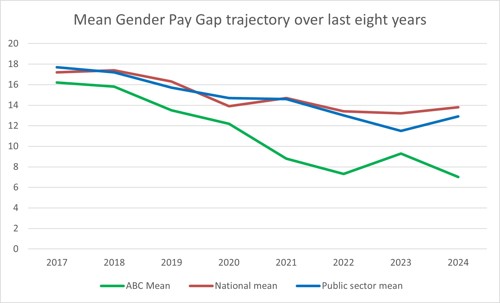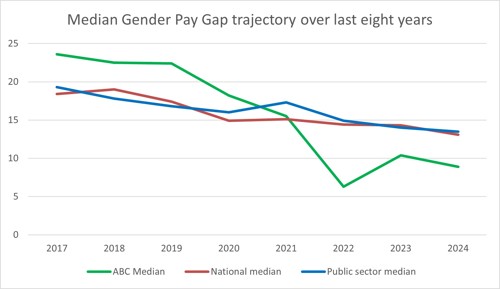
Gender Pay Gap Statistics - March 2024
We continue to welcome the government’s requirement for large organisations to be more transparent on gender pay, and will use this opportunity to nurture our culture of supporting women in the workplace, ensuring success is defined by talent, not gender or circumstance.
What is a gender pay gap?
A gender pay gap is the difference in average pay between the men and women in a workforce, expressed relative to men’s earnings. For example, ‘women earn 15% less than men per hour’.
It is different to equal pay, which is a legal requirement to pay men and women the same for equal or similar work. Ashford Borough Council has a robust job evaluation system which ensures equality of pay.
Having a gender pay gap does not mean that unlawful discrimination is occurring. The majority of organisations will have a gap for varying reasons, some of which are due to much broader influences such as economic, cultural, societal and educational factors.
Our data - 31 March 2024
Mean (average) gender pay gap in hourly pay: 7.0%
Median (mid-point) gender pay gap in hourly pay: 8.9%
| Pay quartile | Men % | Women % |
|---|---|---|
| Top | 50.0 | 50.0 |
| Upper middle | 43.1 | 56.9 |
| Lower middle | 38.2 | 61.8 |
| Lower | 41.2 | 58.8 |
Mean (average) bonus gender pay gap: 10.8%
Median (mid-point) bonus gender pay gap: 0%


Proportion of males and females receiving a bonus payment: Males (66.4%), Females (87.1%)
We do not operate a bonus or performance related pay scheme. The figures behind the bonus gender pay gap result from long service awards (six females and three males), enhanced recruitment pay (one male and two females) and a ‘non-consolidated, one-off, non pensionable payment’ (£250 pro rata for MG8 and under).
The statistics look different this year as we took into account a non-consolidated, one-off, non-pensionable payment given as part of the pay award for 2023/24. This was £250 pro rata for all staff at MG8 and under.
This immediately meant that under the legislation more females than males received a ‘bonus’ payment. However because the payment was pro rata and more women are part time, this combined with long service awards and enhanced recruitment pay showed males receiving slightly more on average. The bonus gap is expressed as the difference in average pay between the men and women in a workforce, expressed relative to men’s earnings.
At mid-point there was no difference in payment due to the large numbers of both genders receiving the same amount.
What do our calculations mean?
It is good news that our gender pay gap has reduced and we will continue to ensure women have the same opportunities as men to fulfil their workplace potential.
Our pay structure, policies, recruitment procedures and training programme are set without bias to gender or any other personal characteristic. We also know many of these policies and procedures assist both our male and female staff in a work-life balance and career progression opportunities.
Examples of the type of work that we will continue to expand on to assist in closing our gap in the coming years will include:
- Providing interview training for recruiting managers including removing subconscious bias
- Emphasising the value of one to ones and Personal Development Plans
- Speaking to young people at careers fairs using female case studies
- Ensuring training is local where possible
- Highlighting the importance of a work life balance
- Using e-learning and SDI training to recognise our differences, nurture acceptable and eliminate unacceptable behaviour
- Embedding our flexible working and remote working policies and discussing these at interview stage
- Looking at secondment opportunities and flexible ways of recruiting to a post
- Removing current salary details from application form to counter subconscious bias
- Promoting peer support groups (for example for working parents and menopause)
- Keeping our website up to date for job seekers to view relevant policies so they can see our flexible ways of working
- Continuing to support flexible working applications from both genders to destigmatise men working part time and give all opportunity for flexibility






